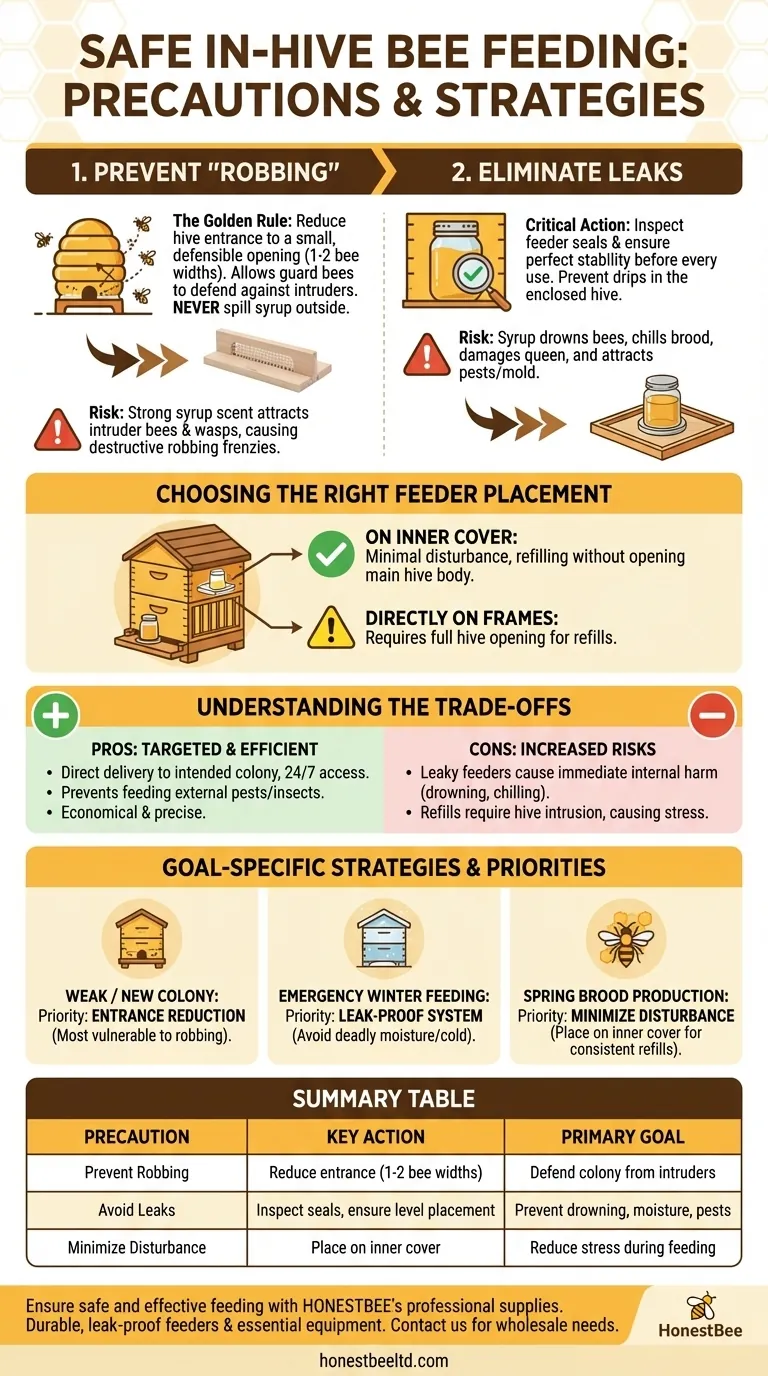To safely feed bees inside the hive, your two most critical precautions are to prevent "robbing" from intruder bees and to eliminate any risk of syrup leaks. You must reduce the hive entrance to a small, defensible opening, and you must ensure your feeder is perfectly sealed and stable to prevent drips that can drown your bees or attract pests.
In-hive feeding is a powerful tool for delivering targeted nutrition, but it artificially concentrates a high-value resource. Your entire strategy must revolve around containing this resource securely within the hive to avoid triggering destructive robbing behavior from other colonies and to prevent accidental harm to your own bees.

The Core Principle: Avoiding Unintended Consequences
Supplemental feeding is an intervention. Like any intervention, it carries the risk of creating new problems if not managed with care. The goal is to provide support without introducing chaos.
Preventing Robbing: The Golden Rule of Feeding
Feeding creates a strong sugar scent that can attract bees from neighboring hives, as well as wasps and other insects. This can incite a "robbing" frenzy where the intruders overwhelm and destroy a weaker colony to steal its resources.
Your primary defense is to reduce the hive entrance to a very small opening, often just one or two bee-widths wide. This allows the colony's guard bees to effectively defend their home against a much larger invading force.
Never spill syrup on or around the hive, as this acts as a powerful and immediate beacon for robbers.
Ensuring a Leak-Proof System
A leaky feeder is one of the most common and dangerous mistakes. Even a slow drip can have severe consequences inside the enclosed hive environment.
Syrup can drown bees, chill the brood nest by increasing moisture, and damage the queen if she becomes coated in it. Furthermore, a sticky mess inside the hive will quickly lead to mold and attract pests like small hive beetles.
Before every use, inspect your feeder's seals and ensure it sits perfectly level and stable on the hive. This is especially critical for jar-style feeders.
Choosing the Right Feeder Placement
Common methods for in-hive jar feeding include placing the feeder directly on the top bars of the frames or on top of the inner cover.
Placing the feeder on the inner cover is generally preferable. It allows you to refill the feeder with minimal disturbance to the colony, as you only need to lift the outer telescoping cover without breaking the propolis seal of the main hive body.
Understanding the Trade-offs
In-hive feeding is not the only method, and it's important to understand its specific advantages and disadvantages.
Pro: Targeted and Efficient Nutrition
This method ensures the food goes directly to the intended colony. It allows bees to access the syrup 24/7, regardless of outside weather conditions.
Because it is contained, it prevents you from accidentally feeding other insects or attracting pests to your apiary. This makes it a very economical and precise way to deliver nutrition.
Con: Increased Risk of In-Hive Disaster
The primary drawback is that any failure occurs directly inside the colony's living space. Unlike an external feeder, a leaky in-hive feeder can cause immediate harm through drowning and chilling.
Con: Requires Hive Intrusion
Refilling an internal feeder requires you to open the hive. While often minimal, this disturbance can break propolis seals and cause stress, especially during cold or inclement weather.
Making the Right Choice for Your Goal
Apply these precautions based on your specific objective for feeding the colony.
- If your primary focus is supporting a weak or new colony: Your absolute priority is entrance reduction, as these hives are the most vulnerable targets for robbing.
- If your primary focus is emergency winter feeding: A perfectly leak-proof system is paramount to avoid introducing deadly moisture and cold into the winter cluster.
- If your primary focus is stimulating spring brood production: Place the feeder for minimal disturbance, like on the inner cover, to allow for consistent refills without repeatedly chilling the brood nest.
Ultimately, successful in-hive feeding is about providing targeted support without creating dependency or danger for the colony.
Summary Table:
| Precaution | Key Action | Primary Goal |
|---|---|---|
| Prevent Robbing | Reduce hive entrance to 1-2 bee widths | Defend colony from intruder bees |
| Avoid Leaks | Inspect feeder seals, ensure level placement | Prevent drowning, moisture, and pests |
| Minimize Disturbance | Place feeder on inner cover for easy refills | Reduce stress during feeding |
Ensure your in-hive feeding is safe and effective with HONESTBEE's professional beekeeping supplies. We supply commercial apiaries and distributors with durable, leak-proof feeders and essential equipment designed for precision and colony health. Contact us today to discuss your wholesale needs and protect your investment.
Visual Guide

Related Products
- Professional Hive Front Entrance Bee Feeder
- Boardman Entrance Bee Feeder Durable Galvanized Steel and Wood Construction for Beekeeping
- HONESTBEE Professional Entrance Bee Feeder Hive Nutrition Solution
- In-Hive Dual Compartment Frame Bee Feeder for Targeted Colony Nutrition
- Professional In-Hive Frame Bee Feeder by HONESTBEE
People Also Ask
- What is an entrance feeder? A Guide to Its Simple Design and High Robbing Risk
- Are entrance feeders good for bees? Prioritize Hive Health Over Convenience
- How does the entrance feeder method work? A Guide to Simple But Risky Hive Feeding
- What are entrance feeders, and where are they located? A Guide to External Hive Feeding
- What is an entrance feeder and how is it used? Avoid the Critical Risk of Robbing



















